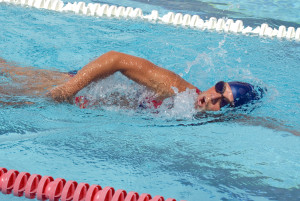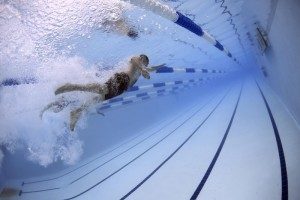Swimming freestyle well requires the entire body to work together. Arms pull you through the water, your core rotates slightly, and your kick provides forward momentum. Effort and power should come from your upper body, core and lower body evenly rather than just one area.
Don’t hold your breath
“If kids learn to swim without formal

lessons, they often take a deep breath and hold it before putting their face in the water,” says Raz Cuparencu, former USA Swimming National Team coach for Open Water World Champion, Ashley Twichell. “But swimmers need to breathe out in a controlled manner rather than hold their breath. That way they’re ready to take in fresh air when it’s time to breathe.” Just like any exercise, it’s important to breathe out during exertion. For example, runners don’t hold their breath while they run because breath holding deprives your muscles of oxygen and causes fatigue.
Take a cue from swim instructors and learn to blow bubbles out of your nose while standing still. Take a deep breath, submerge the lower half of your face, and exhale slowly through your nose and mouth. If you struggle to exhale, try humming as you do it to regulate the release of air.
Don’t lift your head to breathe
Coach Raz says that he corrects young swimmers’ head position frequently when they begin swimming freestyle at Midwest Aquatic Club. Many swimmers lift their head and rotate their neck while breathing. Pulling your head slightly upward changes the alignment of your body, dropping your hips or feet lower and causing drag. When the position of your feet is lower than your hips, it drains your kick of power and causes you more effort, creating more drag than it does to help propel you forward. Low feet drain power from your kick without propelling you forward.
Swimmers should keep their head in line with the body at all times, rotating along the axis of their swim goggles to lift only their face out of the water without lifting their head. Freestyle is a reaching, rotating, finishing stroke. Coaches recommend pretending your entire body is on a pole that allows rotation. Keep your head in line with your body as the arm comes out of the water, rotating the entire body to expose the face and breathe.
Keep your feet and hips from sinking
If your body isn’t in a straight line, the water can’t flow past you efficiently. Swimmers call this increased resistance “drag.” Increased drag slows you down and makes you work harder to move through the water. Unfortunately, lots of movements, including fatigue, cause feet and hips to drop down.
 The goal of swimming freestyle efficiently is to keep the body aligned so your kick can propel you forward. Keeping your hips and head in proper alignment as you reach and rotate allows your body to access every muscle and power you through the water. Depending on the age of the swimmer, he says swimming with a snorkel can allow athletes 13 and up to focus on maintaining proper body alignment.
The goal of swimming freestyle efficiently is to keep the body aligned so your kick can propel you forward. Keeping your hips and head in proper alignment as you reach and rotate allows your body to access every muscle and power you through the water. Depending on the age of the swimmer, he says swimming with a snorkel can allow athletes 13 and up to focus on maintaining proper body alignment.
Fixing freestyle technique is critical
Even the most powerful swimmer needs proper technique to maximize their swimming ability. The difference between first and second place, even in age group swimming, comes down to the basics. Advanced work, like increasing pace, should wait until swimmers have enough endurance and mindfulness to apply proper technique consistently.
What some more drills to help improve your freestyle? Then why not check out theses posts: